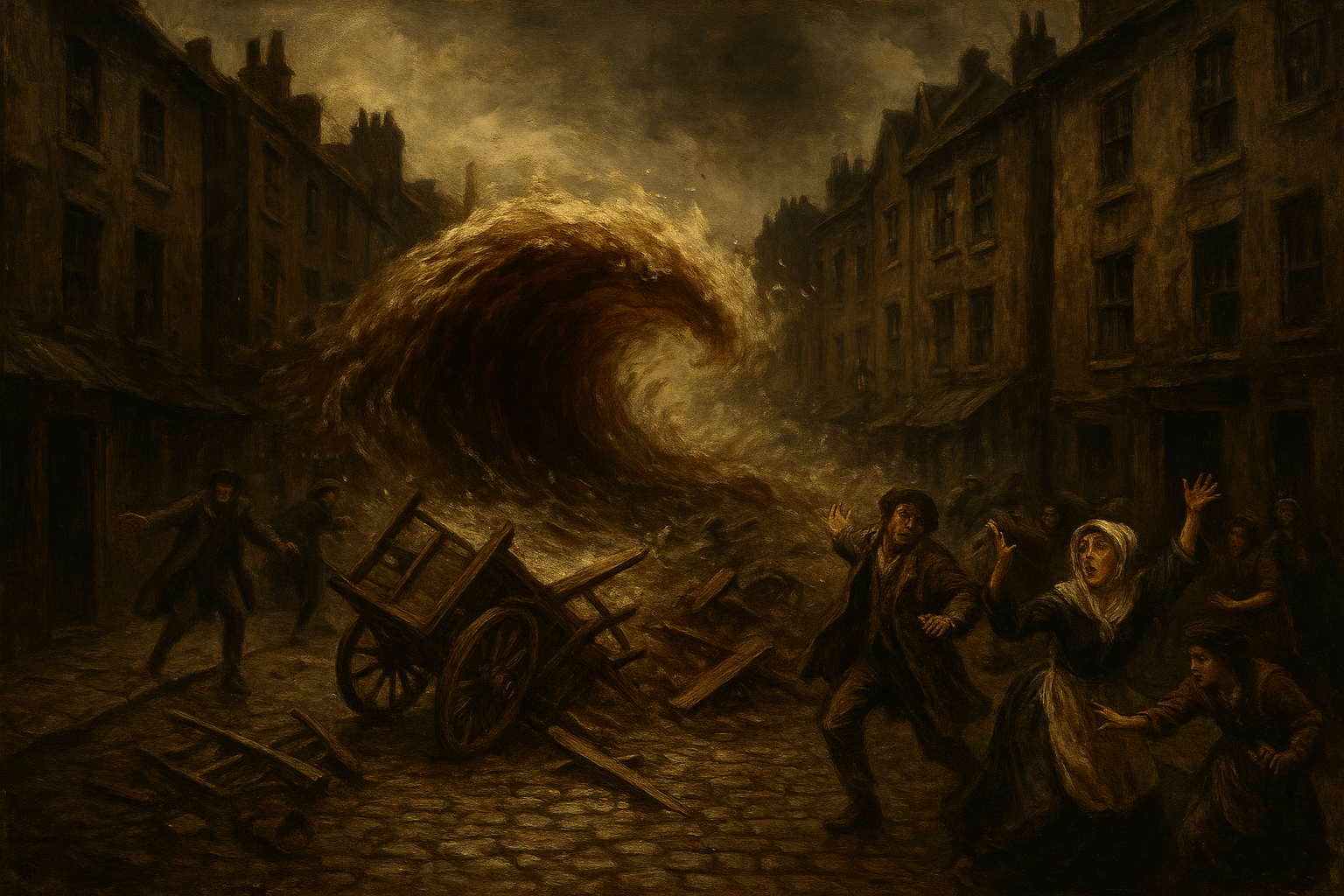The Heart of London’s Brewing Industry
In the early 19th century, London was the undisputed center of the world’s brewing industry. Dominating the scene was a dark, heavy brew called Porter, the preferred drink of the city’s working class. At the heart of this industry stood Meux and Company’s Horse Shoe Brewery on Tottenham Court Road, a titan of production renowned for its immense scale.
The brewery was a marvel of industrial engineering, home to some of the largest fermentation vats in the city. These were not mere barrels; they were colossal wooden cylinders, bound by enormous iron hoops. The largest of them all stood a towering 22 feet high and held a staggering 135,000 imperial gallons (over 610,000 liters) of fermenting Porter. To put that in perspective, it contained enough beer to fill over a million pint glasses. This single vat was a symbol of Meux’s success, but it would soon become the catalyst for catastrophe.
A Deluge of Porter
On that fateful Monday afternoon, a brewery storehouse clerk named George Crick was making his rounds. Around 4:30 PM, he noticed that one of the 700-pound iron rings securing the giant vat had snapped. This was not entirely uncommon, and after a brief inspection, his superior deemed it of no immediate concern, promising to have it fixed later. It was a tragically ill-judged assessment.
Just one hour later, at roughly 5:30 PM, the colossal vat erupted with an explosive force. The second iron ring gave way, and the wooden staves burst open. The resulting blast was so powerful it was reportedly heard up to five miles away. The torrent of hot, fermenting porter, erupting under immense pressure, created a devastating domino effect. The initial wave smashed into a row of other, smaller vats and barrels, including a large cask of porter, compounding the disaster. In moments, the brewery’s rear wall collapsed, and a tidal wave of beer—estimated at over 323,000 imperial gallons, or nearly 1.5 million liters—was unleashed.
The 15-foot-high wave of dark liquid, carrying with it splintered wood and debris, surged into the surrounding neighborhood: the infamous St. Giles Rookery.
Tragedy in the Rookery
The St. Giles Rookery was one of London’s most destitute and overcrowded slums. Here, entire families were crammed into single-room tenements and damp, poorly ventilated basements, making them horribly vulnerable to the sudden inundation. The beer flood was not a comical mishap; for the residents of St. Giles, it was a terrifying and lethal force.
The wave of porter smashed into the dilapidated tenements of New Street, right behind the brewery. Two houses were completely destroyed. In the basement of one, a group of people had gathered for a wake for a two-year-old boy who had died the previous day. The beer flooded the cellar, instantly killing four of the mourners: Ann Saville (the boy’s mother), Catherine Butler, Elizabeth Smith, and Mary Mulvey, along with Mulvey’s three-year-old son, Thomas Murry.
Elsewhere, the destruction continued. The list of the known victims highlights the indiscriminate nature of the tragedy:
- Eleanor Cooper, a 14-year-old girl working as a servant at the Tavistock Arms pub, was buried under a collapsing wall as she washed pots in the pub’s yard.
- Hannah Bamfield, a four-and-a-half-year-old girl, was swept away by the current as she was having tea with her mother.
- A final victim, Sarah Bates, was a child of only three years old.
In total, eight people, mostly women and children, lost their lives. They were not, as urban legend sometimes claims, killed by drinking the free-flowing alcohol. They died from drowning, from the concussive force of the wave, and from being crushed by the debris and crumbling buildings.
The Aftermath and a Bizarre Verdict
The scene in the aftermath was one of chaos and despair. The stench of beer hung heavy in the air for days. Families who had lost everything were forced to display the bodies of their loved ones in their rooms to collect money from onlookers for the funerals. The brewery, meanwhile, faced the prospect of total financial ruin.
An inquest was held just two days later. The coroner’s jury was taken to the site of the disaster to witness the destruction firsthand. They heard testimony from George Crick, the brewery owners, and other witnesses. After deliberating, they returned a verdict that seems utterly bizarre to modern ears: the disaster was an “Act of God.”
Legally, this meant that the flood was ruled to be a natural catastrophe for which no mortal could be held responsible. There was no precedent for such an industrial accident, and the jury found no evidence of negligence on the part of the brewery. It was simply a tragic, unavoidable accident. As a result, Meux & Co. was absolved of all legal responsibility for the deaths and destruction it had caused.
In a final, strange twist, the brewery was not only spared from prosecution but was also saved from bankruptcy. Having already paid excise duty to the Crown on the massive volume of lost beer, the company successfully petitioned Parliament for a refund. They were granted a waiver of around £7,250 (equivalent to hundreds of thousands of pounds today), allowing the business to survive.
The Legacy of the Flood
The London Beer Flood remains a strange and tragic footnote in the city’s history. It served as a grim reminder of the unforeseen dangers of the Industrial Revolution, where new technologies and massive scales of production often outpaced safety regulations. In the wake of the disaster, the brewing industry began a slow transition away from massive, unreliable wooden vats, gradually replacing them with lined concrete fermenters that were far more stable.
Today, nothing remains of the Horse Shoe Brewery. In its place stands the Dominion Theatre. But the memory of the great beer flood lives on, a cautionary tale of industrial might, human vulnerability, and the day the streets of London literally ran with beer.
